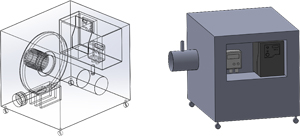
AIR TIGHTNESS PROOF EQUIPMENT
This sealing equipment is designed to evaluate the tightness of the tested tube (Classes A and B).
Not valid for testing or certifying complete installations.
Sealing test kit
Equipment kit to test the sealing in rectangular or circular ducts. It includes a frequency inverter, an equipment of differential pressure, a hot wire speed transmitter and connection accessories. It is used to test the sealing as per the standard EN 1507 2006.
Procedure for testing the connection of the sealing kit for ducting:
- Connect the frequency inverter to 220V single phase. The entries to the electric current and to the inverter are indicated as L1 and L2.
- Connect the inverter to the fan’s motor. The engine must be connected to a 220 V three phase. In this case the rails must be in parallel. The exit connections from the inverter to the motor are indicated in the inverter as U-V-W.
- Connect the 24V power supply to a 220 V single phase.
- Connect the power supply exit to the pressure transmitter PRPEL2500N.
- Connect the power supply exit to the IVL02. The IVL02 must be located at a minimum distance of 400mm from the fan from one side, as well as the other one with a minimum of 400mm until the next element: in case of analysis of depression it will be in the duct to be tested, and in case of overpressure analysis it will be in the air entrance. Everything as it is indicated in the attached scheme.
- Connect one of the pressure tap to the supplied racor (VPELAS), previously installed in the testing duct. The other pressure tap stays without any connection (to the air).
- Check the correct connection as well as the sealing, from the needed accessories to adapt the exit of the fan to the testing duct. Protect all the suspicious points such as the ones to not be able to complete the connection between the adaptation of the duct and the instrumentation equipment with tape or putty to avoid leakage.
- According to the norm EN 1507:2006 regarding sealing, it is exposed the following:
The leakage factor f must be less than the leakage limit fmax. As per the table 1 for any testing pressure (p. assaig) inferior or equal to the designed pressure of operation (p.disseny). The requirements must be achieved for positive and negative pressures. Being the fmax for the sealing CLASS A: (0.027 x p.assaig 0.65 x 10 -3). Being the fmax for sealing CLASS B: (0.009 x p.assaig 0.65 x 10-3). The duct has to bear the static pressure limit (ps) according to the table 1 without any permanent deformation or sudden changes in the leakage flow neither in the pressure of the test.
This way the values and parameters to be tested are the following:
For CLASS A sealing:
Positive: fmax. = 0.001326486 to a pressure of 400 Pa.
Negative: fmax. = 0.000845344 to a pressure of 200 Pa.
For CLASS B sealing:
Positive: fmax. = 0.000442162 to a pressure of 400 Pa
Negative: fmax. = 0.000511179 to a pressure of 500 Pa.
- Start the equipment as per the scheme and the mounting instructions. Using the frequency inverter give speed to the fan until reaching the desired pressure Pa as per the test which is wanted to assess in that moment. Maintain this pressure during a time until it is check the stability of the measure from the inverter and therefore obtain the value of the speed which will allow you know the fmax value, this way, you will know if the value is in compliance with the norm. The test must be performed by connecting the intake impulsion of the fan and after connecting the suction intake of the fan to perform the positive and negative tests.
Check prices.
